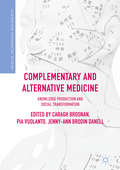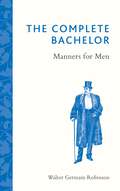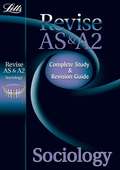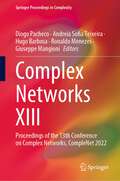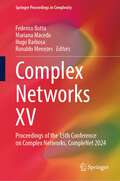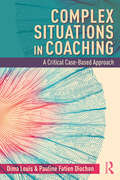- Table View
- List View
Competition with Identity Driven Entry: A Principal Multi-Agent Model on the Success of Mergers and Acquisitions (Management, Organisation und ökonomische Analyse)
by Sebastian BurchhardtSebastian Burchhardt develops a game theory model that analyzes the possible behavioral patterns of employees during M&A processes and the impact of such patterns on the success of the transaction itself. The result is the development of a principal-multi-agent model that allows for endogenous contest entry driven by identity. In addition, the model proposes guidance for practical M&A management.
Competitive Regionalism: FTA Diffusion in the Pacific Rim (International Political Economy Series)
by M. Solís B. Stallings S. KatadaDespite abundant scepticism about their economic benefits, Free Trade Agreements (FTAs) have proliferated at a rapid pace. Policy diffusion models explain how different sets of preferential trade agreements are interconnected and establish under what conditions FTAs can work for or against the emergence of coherent regional blocs.
Competitive Spirits: Latin America's New Religious Economy
by R. Andrew ChesnutFor over four centuries the Catholic Church enjoyed a religious monopoly in Latin America in which potential rivals were repressed or outlawed. Latin Americans were born Catholic and the only real choice they had was whether to actively practice the faith. Taking advantage of the legal disestablishment of the Catholic Church between the late 1800s and the early 1900s, Pentecostals almost single-handedly built a new pluralist religious economy. By the 1950s, many Latin Americans were free to choose from among the hundreds of available religious "products," a dizzying array of religious options that range from the African-Brazilian religion of Umbanda to the New Age group known as the Vegetable Union. R. Andrew Chesnut shows how the development of religious pluralism over the past half-century has radically transformed the "spiritual economy" of Latin America. In order to thrive in this new religious economy, says Chesnut, Latin American spiritual "firms" must develop an attractive product and know how to market it to popular consumers. Three religious groups, he demonstrates, have proven to be the most skilled competitors in the new unregulated religious economy. Protestant Pentecostalism, the Catholic Charismatic Renewal, and African diaspora religions such as Brazilian Candomble and Haitian Vodou have emerged as the most profitable religious producers. Chesnut explores the general effects of a free market, such as introduction of consumer taste and product specialization, and shows how they have played out in the Latin American context. He notes, for example, that women make up the majority of the religious consumer market, and explores how the three groups have developed to satisfy women's tastes and preferences. Moving beyond the Pentecostal boom and the rise and fall of liberation theology, Chesnut provides a fascinating portrait of the Latin American religious landscape.
Complacency: Classics and Its Displacement in Higher Education (Critical Antiquities)
by John T. HamiltonA critical reflection on complacency and its role in the decline of classics in the academy. In response to philosopher Simon Blackburn’s portrayal of complacency as a vice that impairs university study at its core, John T. Hamilton examines the history of complacency in classics and its implications for our contemporary moment. The subjects, philosophies, and literatures of ancient Greece and Rome were once treated as the foundation of learning, with everything else devolving from them. Hamilton investigates what this model of superiority, derived from the golden age of the classical tradition, shares with the current hegemony of mathematics and the natural sciences. He considers how the qualitative methods of classics relate to the quantitative positivism of big data, statistical reasoning, and presumably neutral abstraction, which often dismiss humanist subjectivity, legitimize self-sufficiency, and promote a fresh brand of academic complacency. In acknowledging the reduced status of classics in higher education today, he questions how scholarly striation and stagnation continue to bolster personal, ethical, and political complacency in our present era.
Complacency: Classics and Its Displacement in Higher Education (Critical Antiquities)
by John T. HamiltonA critical reflection on complacency and its role in the decline of classics in the academy. In response to philosopher Simon Blackburn’s portrayal of complacency as a vice that impairs university study at its core, John T. Hamilton examines the history of complacency in classics and its implications for our contemporary moment. The subjects, philosophies, and literatures of ancient Greece and Rome were once treated as the foundation of learning, with everything else devolving from them. Hamilton investigates what this model of superiority, derived from the golden age of the classical tradition, shares with the current hegemony of mathematics and the natural sciences. He considers how the qualitative methods of classics relate to the quantitative positivism of big data, statistical reasoning, and presumably neutral abstraction, which often dismiss humanist subjectivity, legitimize self-sufficiency, and promote a fresh brand of academic complacency. In acknowledging the reduced status of classics in higher education today, he questions how scholarly striation and stagnation continue to bolster personal, ethical, and political complacency in our present era.
Complementary and Alternative Medicine: Knowledge Production and Social Transformation (Health, Technology and Society)
by Caragh Brosnan Pia Vuolanto Jenny-Ann Brodin DanellThis book examines how complementary and alternative medicine (CAM) – as knowledge, philosophy and practice – is constituted by, and transformed through, broader social developments. Shifting the sociological focus away from CAM as a stable entity that elicits perceptions and experiences, chapters explore the forms that CAM takes in different settings, how global social transformations elicit varieties of CAM, and how CAM philosophies and practices are co-produced in the context of social change. Through engagement with frameworks from Science and Technology Studies (STS), CAM is reconceptualised as a set of practices and knowledge-making processes, and opened up to new forms of analysis. Part 1 of the book explores how and why boundaries within CAM and between CAM and other health practices, are being constructed, challenged and changed. Part 2 asks how CAM as material practice is shaped by politics and regulation in a range of national settings. Part 3 examines how evidence is being produced and used in CAM research and practice. Including studies of CAM in Eastern and Western Europe, Asia, and North and South America, the volume will appeal to postgraduate students, researchers and health practitioners.
Complementary and Alternative Medicine: Knowledge Production and Social Transformation (Health, Technology and Society)
by Caragh Brosnan Pia Vuolanto Jenny-Ann Brodin DanellThis book examines how complementary and alternative medicine (CAM) – as knowledge, philosophy and practice – is constituted by, and transformed through, broader social developments. Shifting the sociological focus away from CAM as a stable entity that elicits perceptions and experiences, chapters explore the forms that CAM takes in different settings, how global social transformations elicit varieties of CAM, and how CAM philosophies and practices are co-produced in the context of social change. Through engagement with frameworks from Science and Technology Studies (STS), CAM is reconceptualised as a set of practices and knowledge-making processes, and opened up to new forms of analysis. Part 1 of the book explores how and why boundaries within CAM and between CAM and other health practices, are being constructed, challenged and changed. Part 2 asks how CAM as material practice is shaped by politics and regulation in a range of national settings. Part 3 examines how evidence is being produced and used in CAM research and practice. Including studies of CAM in Eastern and Western Europe, Asia, and North and South America, the volume will appeal to postgraduate students, researchers and health practitioners.
The Complete Bachelor: Manners for Men
by Walter Germain RobinsonBursting with witty, practical advice on the ins and outs of etiquette, from how one should dress for a formal occasion to what behaviour one should adopt while travelling abroad, this guide will help every modern man to deport himself with poise in all types of public and social situations.
Complete Data Analysis Using R: Your Applied Manual
by Marco LehmannThis step-by-step guide shows you how to use R to get data analysis right. The book explores the entire process of analysis, covering key steps from preparing your data to putting your analysis together and writing up your findings. It helps you get to grips with doing different statistical techniques in R and: Equips you with practical data visualisation tools to create graphs and tables. Shows you how to prepare and present your research for assessment, publication and dissemination. Covers key issues facing today’s social scientists, such as making research reproducible. Features include an introduction to each chapter, and end-of-chapter exercises to check your understanding of the material. The online resources for this text include data sets that you can perform your own analysis on, and links to publications that are relevant to programming with R. A good starting point for any postgraduate student conducting a research project, this book will help you develop your statistics and programming knowledge and get quickly up to speed.
Complete Data Analysis Using R: Your Applied Manual
by Marco LehmannThis step-by-step guide shows you how to use R to get data analysis right. The book explores the entire process of analysis, covering key steps from preparing your data to putting your analysis together and writing up your findings. It helps you get to grips with doing different statistical techniques in R and: Equips you with practical data visualisation tools to create graphs and tables. Shows you how to prepare and present your research for assessment, publication and dissemination. Covers key issues facing today’s social scientists, such as making research reproducible. Features include an introduction to each chapter, and end-of-chapter exercises to check your understanding of the material. The online resources for this text include data sets that you can perform your own analysis on, and links to publications that are relevant to programming with R. A good starting point for any postgraduate student conducting a research project, this book will help you develop your statistics and programming knowledge and get quickly up to speed.
Complete Data Analysis Using R: Your Applied Manual
by Marco LehmannThis step-by-step guide shows you how to use R to get data analysis right. The book explores the entire process of analysis, covering key steps from preparing your data to putting your analysis together and writing up your findings. It helps you get to grips with doing different statistical techniques in R and: Equips you with practical data visualisation tools to create graphs and tables. Shows you how to prepare and present your research for assessment, publication and dissemination. Covers key issues facing today’s social scientists, such as making research reproducible. Features include an introduction to each chapter, and end-of-chapter exercises to check your understanding of the material. The online resources for this text include data sets that you can perform your own analysis on, and links to publications that are relevant to programming with R. A good starting point for any postgraduate student conducting a research project, this book will help you develop your statistics and programming knowledge and get quickly up to speed.
The Complete Guide to Mergers and Acquisitions: Process Tools to Support M&A Integration at Every Level
by Timothy J. GalpinEase the M&A process with a more effective integration plan The Complete Guide to Mergers and Acquisitions is the ultimate handbook for planning and managing post-merger integration. Packed full of "how to" guidance, tools, templates and resources that have been put to the test on numerous due diligence and integration efforts around the world, The Complete Guide to Mergers and Acquisitions has been the go-to guide for firms seeking to maximize the value of their deals since the release of the first edition in 1999. Poor integration management virtually ensures that a merger or acquisition will fail to meet financial and strategic goals. The Complete Guide to Mergers and Acquisitions provides the information that enables firms to quickly and prudently capture projected cost and revenue synergies, and to move the combined organization forward. The book addresses strategic deal considerations, due diligence, integration management, people dynamics and cultural integration, common integration mistakes, communications strategies, and provides actionable steps toward creating measurable, positive results throughout the integration process. The updated third edition contains new information and tools to help firms in any industry manage deals of all sizes, including: Results of The State of M&A Integration Effectiveness Survey, 2014 A new chapter on the M&A process deal stages, with an expanded Deal Flow Model Findings of substantial M&A research from various studies in multiple industries and organizations, supporting the concepts presented throughout the book New and revised tools and templates for due diligence, integration, and results measurement and reporting New case examples of recent transactions Highlighted 'Key Principles' throughout each chapter A summary of key points at the end of each chapter Discussion questions addressing the key themes of each chapter A 'rapid assessment' diagnostic regarding the key elements of each chapter, which can be completed for any organization A revised chapter on taking your M&A game to the next level – essential requirements for building M&A capabilities into a consistently successful enterprise competency Merger and acquisition activity across the globe continues to grow, and is also playing a major role in the development of expanding markets. A well-managed integration effort is essential to success, and failure means a tremendous waste in terms of time and money, as well as the rapid destruction of shareholder value. The Complete Guide to Mergers and Acquisitions: Process Tools to Support M&A Integration at Every Level, Third Edition is an invaluable resource to guide firms in managing M&A integration and maximize the value of their deals.
The Complete Guide to Mergers and Acquisitions: Process Tools to Support M&A Integration at Every Level
by Timothy J. GalpinEase the M&A process with a more effective integration plan The Complete Guide to Mergers and Acquisitions is the ultimate handbook for planning and managing post-merger integration. Packed full of "how to" guidance, tools, templates and resources that have been put to the test on numerous due diligence and integration efforts around the world, The Complete Guide to Mergers and Acquisitions has been the go-to guide for firms seeking to maximize the value of their deals since the release of the first edition in 1999. Poor integration management virtually ensures that a merger or acquisition will fail to meet financial and strategic goals. The Complete Guide to Mergers and Acquisitions provides the information that enables firms to quickly and prudently capture projected cost and revenue synergies, and to move the combined organization forward. The book addresses strategic deal considerations, due diligence, integration management, people dynamics and cultural integration, common integration mistakes, communications strategies, and provides actionable steps toward creating measurable, positive results throughout the integration process. The updated third edition contains new information and tools to help firms in any industry manage deals of all sizes, including: Results of The State of M&A Integration Effectiveness Survey, 2014 A new chapter on the M&A process deal stages, with an expanded Deal Flow Model Findings of substantial M&A research from various studies in multiple industries and organizations, supporting the concepts presented throughout the book New and revised tools and templates for due diligence, integration, and results measurement and reporting New case examples of recent transactions Highlighted 'Key Principles' throughout each chapter A summary of key points at the end of each chapter Discussion questions addressing the key themes of each chapter A 'rapid assessment' diagnostic regarding the key elements of each chapter, which can be completed for any organization A revised chapter on taking your M&A game to the next level – essential requirements for building M&A capabilities into a consistently successful enterprise competency Merger and acquisition activity across the globe continues to grow, and is also playing a major role in the development of expanding markets. A well-managed integration effort is essential to success, and failure means a tremendous waste in terms of time and money, as well as the rapid destruction of shareholder value. The Complete Guide to Mergers and Acquisitions: Process Tools to Support M&A Integration at Every Level, Third Edition is an invaluable resource to guide firms in managing M&A integration and maximize the value of their deals.
Complete Study And Revision - Sociology (Letts A Level Success Ser.)
by Steve ChapmanLevel: A Level Subject: Sociology Revise for AS & A2 Sociology with confidence! Providing complete study support throughout the two A Level years, this Sociology study guide matches the curriculum content and provides in-depth course coverage, plus invaluable advice on how to get the best results in the exams. Providing plenty of exam practice and frequent progress checks and questions to consolidate learning, this AS & A2 Sociology study guide contains invaluable advice and preparation for the exam. Included in this book: • examiner's tips that reveal how to achieve higher marks • exam board labels that allow students to identify content relevant to their course • information presented in a clear and easy-to-use format • highlighted key points and examiner's hints to offer guidance • progress check questions to test recall and understanding • sample questions and model answers that reveal what examiners are looking for • exam-style questions and answers that provide crucial exam practice • sociological research studies referenced throughout
Complete Training: From Recruitment to Retirement
by Robin HoyleThe training and development needs of any workforce vary dramatically between the generations and levels even so far as the style of communication needed to be effective.At the same time training budgets are tighter than ever before and training departments are increasing marginalised as informal learning in a cyber workplace grows. So how can you tackle the challenges of this environment effectively?Complete Training looks at the employee life cycle and posits a series of training challenges and opportunities relevant across each stage - from new hires to the éminence grise of the organisation - the objective is to enable learning and development practitioners to build individual capability and an organisation with a memory, continually learning from its own endeavours. By looking at how learning organisations succeed, complete training seeks to re-position L&D as central to the business, central to strategy and central to the organization's mission.
Complex Democracy: Varieties, Crises, and Transformations
by Volker Schneider Burkard EberleinThis book presents a state-of-the art collection of original contributions on democracy, addressing three related themes: the complexity of modern democracies and their structural diversity; coping strategies of democracies in times of crises; and current and potential trajectories and transformations of democracy. The first part of the book maps the democratic landscape by revealing the diversity of democratic political systems, through either comparative analysis or case studies on the specific nature of political and administrative systems in interest intermediation and identity construction. The second part presents articles that investigate the response of democracies to times of crisis, with an emphasis on political economies and policy processes within the European Union. The third part offers studies on democracies that explore their adaptive potential in the context of globalization and in that of broader technical, institutional or cultural changes.
A Complex Integral Realist Perspective: Towards A New Axial Vision
by Paul MarshallThis book sketches the contours of a vision that moves beyond the dominant paradigm or worldview that underlies and governs modernity (and postmodernity). It does so by drawing on the remarkable leap in human consciousness that occurred during the Axial Age and on a cross-pollination of what are arguably the three most comprehensive integrative metatheories available today: Complex thought, integral theory and critical realism – i.e. a complex integral realism. By deploying the three integrative metatheories this book recounts how the seeds of a number of biases within the Western tradition – analytical over dialectical, epistemology over ontology, presence over absence and exterior over interior – were first sown in axial Greece, later consolidated in European modernity and then challenged throughout the 20th century. It then discusses the remedies provided by the three integrative philosophies, remedies that have paved the way for a new vision. Outlining a ‘new axial vision’ for the twenty-first century which integrates the best of premodernity, modernity and postmodernity within a complex integral realist framework, this book will be of interest to students and scholars of the Axial Age, critical realism, integral theory and complex thought. It will also appeal to those interested in a possible integration of the insights and knowledge gleaned by science, spirituality and philosophy.
A Complex Integral Realist Perspective: Towards A New Axial Vision
by Paul MarshallThis book sketches the contours of a vision that moves beyond the dominant paradigm or worldview that underlies and governs modernity (and postmodernity). It does so by drawing on the remarkable leap in human consciousness that occurred during the Axial Age and on a cross-pollination of what are arguably the three most comprehensive integrative metatheories available today: Complex thought, integral theory and critical realism – i.e. a complex integral realism. By deploying the three integrative metatheories this book recounts how the seeds of a number of biases within the Western tradition – analytical over dialectical, epistemology over ontology, presence over absence and exterior over interior – were first sown in axial Greece, later consolidated in European modernity and then challenged throughout the 20th century. It then discusses the remedies provided by the three integrative philosophies, remedies that have paved the way for a new vision. Outlining a ‘new axial vision’ for the twenty-first century which integrates the best of premodernity, modernity and postmodernity within a complex integral realist framework, this book will be of interest to students and scholars of the Axial Age, critical realism, integral theory and complex thought. It will also appeal to those interested in a possible integration of the insights and knowledge gleaned by science, spirituality and philosophy.
Complex Interpersonal Conflict Behaviour: Theoretical Frontiers (Essays in Social Psychology)
by Evert Van der VliertThis book is about reactions to interpersonal conflict such as avoiding, negotiating, and fighting. It breaks away from the prevailing assumption that conflict behaviours are mutually isolated reactions having mutually isolated effects. Instead, reactions are viewed as components of complex conflict behaviour that influence each other's impact on the substantive and relational outcomes. The simultaneous and sequential occurrence of, for example, problem solving and fighting should therefore be studied together and not separately. The author presents a ladder of stepwise increases in theoretical quality, and designs the sequence of chapters in such a way that the theoretical value increases step by step. The lower steps lead to the description of behavioural components and to a model of integrative and distributive dimensions. The upper steps lead to the dimensions of dual concern for one's own and the other's goals and to complexity explanations in terms of the novel paradigm of conglomerated conflict behaviour. The chapters are summarised into thirty-four interrelated propositions. Six empirical studies demonstrate the validity of crucial propositions at each level of the theoretical framework. This monograph primarily reaches out to an academic readership. However, due to its clear structure, its comprehensive propositions, its frequent use of figures, and its glossary, the book will also provide an invaluable resource for any student and practitioner interested in conflict management and negotiation.
Complex Interpersonal Conflict Behaviour: Theoretical Frontiers (Essays in Social Psychology)
by Evert Van der VliertThis book is about reactions to interpersonal conflict such as avoiding, negotiating, and fighting. It breaks away from the prevailing assumption that conflict behaviours are mutually isolated reactions having mutually isolated effects. Instead, reactions are viewed as components of complex conflict behaviour that influence each other's impact on the substantive and relational outcomes. The simultaneous and sequential occurrence of, for example, problem solving and fighting should therefore be studied together and not separately. The author presents a ladder of stepwise increases in theoretical quality, and designs the sequence of chapters in such a way that the theoretical value increases step by step. The lower steps lead to the description of behavioural components and to a model of integrative and distributive dimensions. The upper steps lead to the dimensions of dual concern for one's own and the other's goals and to complexity explanations in terms of the novel paradigm of conglomerated conflict behaviour. The chapters are summarised into thirty-four interrelated propositions. Six empirical studies demonstrate the validity of crucial propositions at each level of the theoretical framework. This monograph primarily reaches out to an academic readership. However, due to its clear structure, its comprehensive propositions, its frequent use of figures, and its glossary, the book will also provide an invaluable resource for any student and practitioner interested in conflict management and negotiation.
Complex Networks XIII: Proceedings of the 13th Conference on Complex Networks, CompleNet 2022 (Springer Proceedings in Complexity)
by Diogo Pacheco Andreia Sofia Teixeira Hugo Barbosa Ronaldo Menezes Giuseppe MangioniThis book contains contributions presented at the 13th International Conference on Complex Networks (CompleNet), April 19–22, 2022. CompleNet is an international conference on complex networks that brings together researchers and practitioners from diverse disciplines—from sociology, biology, physics, and computer science—who share a passion to better understand the interdependencies within and across systems. CompleNet is a venue to discuss ideas and findings about all types of networks, from biological to technological and to informational and social. It is this interdisciplinary nature of complex networks that CompleNet aims to explore and celebrate.
Complex Networks XV: Proceedings of the 15th Conference on Complex Networks, CompleNet 2024 (Springer Proceedings in Complexity)
by Federico Botta Mariana Macedo Hugo Barbosa Ronaldo MenezesThe International Conference on Complex Networks (CompleNet) brings together researchers and practitioners from diverse disciplines working on areas related to complex networks. CompleNet has been an active conference since 2009. Over the past two decades, we have witnessed an exponential increase in the number of publications and research centres dedicated to this field of Complex Networks (aka Network Science). From biological systems to computer science, from technical to informational networks, and from economic to social systems, complex networks are becoming pervasive for dozens of applications. It is the interdisciplinary nature of complex networks that CompleNet aims to capture and celebrate. The CompleNet conference is one of the most cherished events by scientists in our field. Maybe it is because of its motivating format, consisting of plenary sessions (no parallel sessions); or perhaps the reason is that it finds the perfect balance between young and senior participation, a balance in the demographics of the presenters, or perhaps it is just the quality of the work presented.
Complex Sciences: First International Conference, Complex 2009, Shanghai, China, February 23-25, 2009. Revised Selected Papers (Lecture Notes of the Institute for Computer Sciences, Social Informatics and Telecommunications Engineering #4)
by Jie ZhouI was invited to join the Organizing Committee of the First International Conference on Complex Sciences: Theory and Applications (Complex 2009) as its ninth member. At that moment, eight distinguished colleagues, General Co-chairs Eugene Stanley and Gaoxi Xiao, Technical Co-chairs János Kertész and Bing-Hong Wang, Local Co-chairs Hengshan Wang and Hong-An Che, Publicity Team Shi Xiao and Yubo Wang, had spent hundreds of hours pushing the conference half way to its birth. Ever since then, I have been amazed to see hundreds of papers flooding in, reviewed and commented on by the TPC members. Finally, more than 200 contributions were - lected for the proceedings currently in your hands. They include about 200 papers from the main conference (selected from more than 320 submissions) and about 33 papers from the five collated workshops: Complexity Theory of Art and Music (COART) Causality in Complex Systems (ComplexCCS) Complex Engineering Networks (ComplexEN) Modeling and Analysis of Human Dynamics (MANDYN) Social Physics and its Applications (SPA) Complex sciences are expanding their colonies at such a dazzling speed that it - comes literally impossible for any conference to cover all the frontiers.
Complex Situations in Coaching: A Critical Case-Based Approach
by Dima Louis Pauline Fatien DiochonComplex Situations in Coaching is a collection of 20 typical yet underdiscussed issues in coaching, ranging from value conflicts, multiple agendas, power dynamics, and emotion management, to the role of money, etc. Organized into ten chapters, they are positioned into the literature and commented on by world-class coaches, coaching researchers, educators, and program directors. This plurality of voices is designed to foster dialogue, questions, and solutions; this setting, supportive of reflexivity, critical thinking, and diversity awareness, is essential to the development and education of coaches in an increasingly complex world where ready-made solutions prove limited. Thus, beyond a 'toolkit approach', this book engages in a thought-provoking and multi-perspective journey in support of the professionalization and continuous education of coaches, instructors, and/or supervisors.
Complex Situations in Coaching: A Critical Case-Based Approach
by Dima Louis Pauline Fatien DiochonComplex Situations in Coaching is a collection of 20 typical yet underdiscussed issues in coaching, ranging from value conflicts, multiple agendas, power dynamics, and emotion management, to the role of money, etc. Organized into ten chapters, they are positioned into the literature and commented on by world-class coaches, coaching researchers, educators, and program directors. This plurality of voices is designed to foster dialogue, questions, and solutions; this setting, supportive of reflexivity, critical thinking, and diversity awareness, is essential to the development and education of coaches in an increasingly complex world where ready-made solutions prove limited. Thus, beyond a 'toolkit approach', this book engages in a thought-provoking and multi-perspective journey in support of the professionalization and continuous education of coaches, instructors, and/or supervisors.




